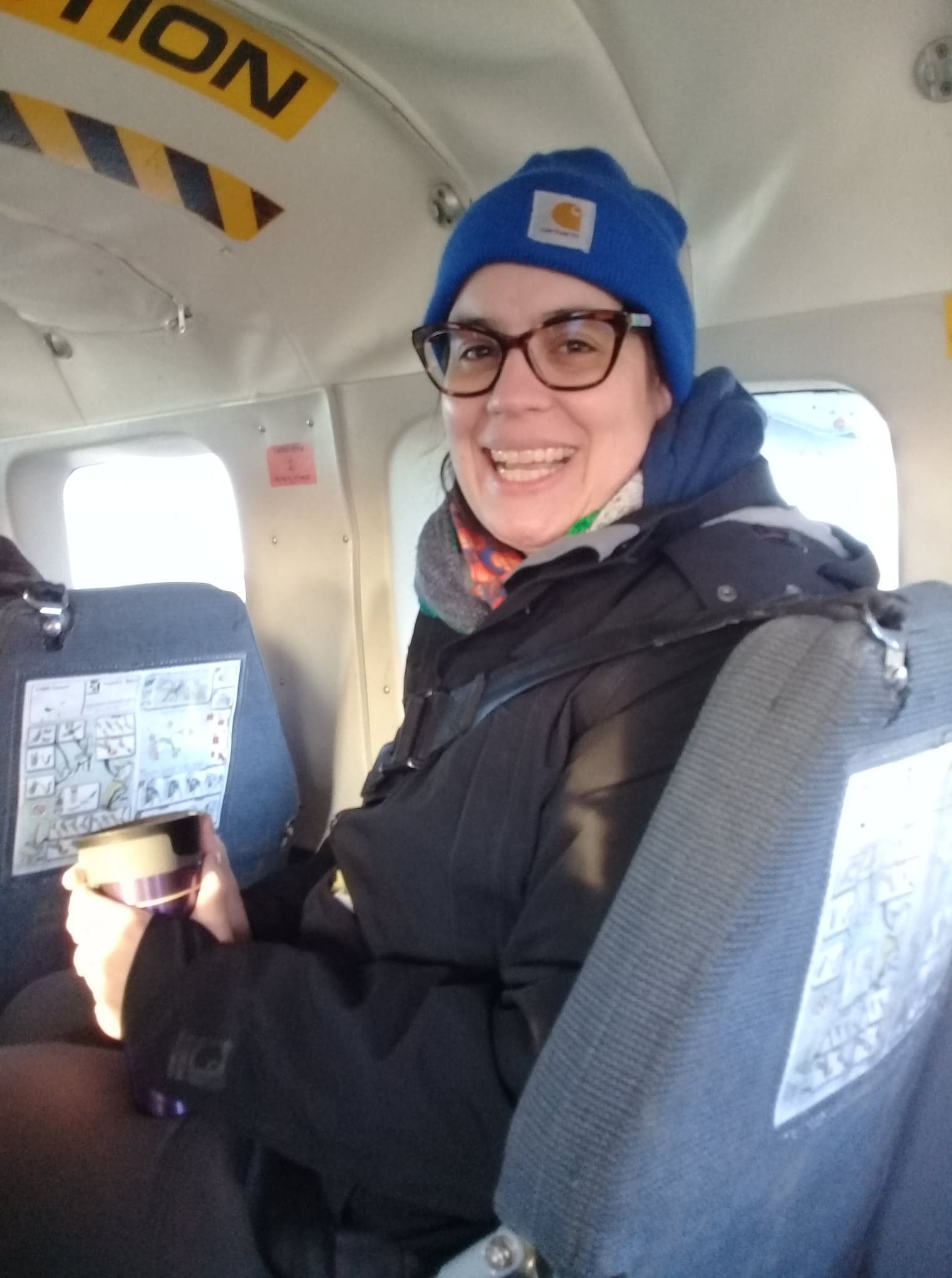![Across 11 schools in 8 Iñupiaq villages, this district librarian uses Sora to spread reading to students [Sora Spotlight]](https://companyoverdrive.cdn.overdrive.com/wp-content/uploads/2024/05/eh-sora-spotlight-feature-image-v2-1000x563-1.png)
Across 11 schools in 8 Iñupiaq villages, this district librarian uses Sora to spread reading to students [Sora Spotlight]
The Sora Spotlight series profiles educators who’ve become Sora champions at their school, impressing us with their creative strategies to get more students reading digitally. To inspire us all to find new ways to reach learners across our communities, we’ve asked them to share their stories of reading success.
Today, we’ll talk to Erin Hollingsworth, District Librarian at North Slope Borough School District (NSBSD) in northern Alaska.
Educator Stats:
 Name:
Name:
Erin Hollingsworth
Describe your position and your school.
The North Slope Borough School District (NSBSD), at the top of Alaska, is the northernmost and geographically largest school district in the United States. With a land area of approximately 90,000 square miles, the NSBSD is larger than 39 US states. There are about 2,000 students, preschool to grade 12, spread out over 11 schools in eight communities across the North Slope.
 As the District Librarian, my office is in the hub community of Utqiaġvik at Fred Ipalook Elementary School, the largest elementary school in the state of Alaska with about 500 students, preschool to grade 5 and 40 teachers. There are no roads connecting communities on the North Slope, so I fly in small bush planes to the schools in the seven other Iñupiaq villages. When I am not providing fly-in library services, I work with the Curriculum & Instruction team to continue to support the educators and students of the NSBSD.
As the District Librarian, my office is in the hub community of Utqiaġvik at Fred Ipalook Elementary School, the largest elementary school in the state of Alaska with about 500 students, preschool to grade 5 and 40 teachers. There are no roads connecting communities on the North Slope, so I fly in small bush planes to the schools in the seven other Iñupiaq villages. When I am not providing fly-in library services, I work with the Curriculum & Instruction team to continue to support the educators and students of the NSBSD.
How many years have you been active with OverDrive?
NSBSD has been active with OverDrive for the past 7 years.
What are you currently reading?
Eagle Drums by Nasuġraq Rainey Hopson and Parable of the Sower by Octavia E. Butler.
Erin’s Sora story
Why do you love Sora?/What do you love most about Sora?
Sora allows for resource sharing in wonderful ways. The smallest school in the district has about 60 students, preschool to grade 12, while the largest school has about 500 students, preschool to grade 5. Using digital resources allows for students to have equal access to materials. It’s also great that the items can be checked out and downloaded to a device; this makes it possible for students to use digital library items, even if they do not have internet access at home. I am also able to provide items to educators and students on demand. This is huge when you consider the amount of time it takes to ship physical books to remote Alaskan villages. Students can have access to the ALA award winners the same day they are announced.
What unique things have you done to help increase student engagement with Sora?
I am fortunate to have the opportunity to travel to schools and visit with students. When I fly into a village, I spend all my time at the school. (Sometimes I even live at the school, sleeping in the library during my visit.) This allows me to push into classrooms and build personal relationships with students and the adults in the buildings. They open up and share what they enjoy. I use this time to get everyone signed into Sora and I actively listen to suggestions from folks.
This is also a great time to demonstrate to educators the many resources in Sora that supplement their instruction. Collection development starts at that classroom level for me.

In what ways has this been successful?
During one of my trips to a village school in October 2023, some very excited students shared with me that they were eagerly anticipating the release of the I Survived the Great Alaska Earthquake, 1964 (I Survived #23) title. I took this information and ordered extra print copies and audiobooks for Sora. I also created a cheeky collection titled “I Survived Mr. —-‘s Class” on the Sora homepage.
Students across the district loved the collection and I saw a huge increase in the circulation of the titles included. Highlighted collections that are tailored to students have really been key to getting the increased usage. Students are hooked when they see titles of immediate interest. With time, they develop an ease and familiarity with Sora. Eventually, they begin to search for titles and make requests.
It has been a journey of growth, but I am seeing numbers that indicate more students are participating in leisure reading with access to a wider variety of materials than what would be able to physically fit within the smaller school library spaces.
 Is there anything you are planning to do or did do to roll out and introduce Sora to your students or staff?
Is there anything you are planning to do or did do to roll out and introduce Sora to your students or staff?
The District Library is always included in the NSBSD New Hire Orientation, and it is often a part of district-wide in-service days. However, I find the best results come from traveling to schools and signing in with students in their classrooms. It is always great fun to take control of the projector and share a read aloud with a class. It is an unexpected treat for the students and demonstrates ways to utilize technology that some educators may not have considered. I LOVE to do this with the Inhabit Media audiobooks because it allows the audience to hear stories in an Inuit language, which helps to reinforce the interconnectedness of the circumpolar cultures.
Do you have any exciting ideas you want to try or anything upcoming that you’re looking forward to with Sora?
I recently learned how to host locally created materials on Sora. I am in collaboration with the Alaska State Library to host student created Iñupiaq language materials in the shared Alaska Digital School Library collection. It is exciting to have a possible venue for students to share their hard work. Plus, it also contributes culturally accurate Iñupiaq materials for the rest of the user in the state to access.
This project is still in the works, but everyone is excited about the direction in which it is headed.
Have you worked with anyone in your district to use Sora for curriculum? Are there any ways that you’ve found to get teachers and students using Sora in the classroom?
As a member of the NSBSD Curriculum & Instruction team, I frequently work with the specialists to find ways to use Sora to supplement daily classroom instruction. We collaborate to build collections of complementary texts for the primary reading programs, student research projects, and many others. Sora has also been a great tool to provide collections that center around the local Iñupiaq Cultural Values.
Each month one of the twelve Iñupiaq values is highlighted; having a Sora collection of supporting materials can be helpful starting place for educators new to the region and the Iñupiaq culture.
Is there anything else you want readers to know about your implementation of Sora?
Sora is a tool that allows for [the premise of] Dr. Rudine Sims Bishop’s 1990 essay, “Mirrors, Windows, & Sliding Glass Doors,” to be put into practice. Collections reflect and mirror student experiences with the strong help of the content published by Inuit owned Inhabit Media. They provide windows to the ways of other cultures. They provide pathways to the world beyond the Arctic.
To add Dr. Debbie Reese’s curtains, the ability to curate collections also allows for the creation and promotion of materials created by authentic voices. Sora allows for the tailoring of collections that meet these needs in a strength-based, local manner through a tool that can be shared across a very large school district.
Get to know Erin
In your opinion, why is reading digitally important, especially to student readers?
Many of the communities on the North Slope are a two hour jet flight from the nearest bookstore. The state of Alaska does not require schools to have libraries. Access to digital content allows for students to remain current in a rapidly changing world. When you live in a location where newspapers arrive weeks late, digital information can be a lifeline. Learning to navigate digital platforms and to search for information is a skill that transfers beyond the context of the library and will be beneficial to students as they go on to life outside of the schoolhouse.
What is your favorite reading moment with a student?
My favorite reading moment came when I helped a high school student find connection through literature. They were having a difficult time navigating life issues and felt isolated and alone. After visiting, I was able to suggest a wide variety of titles. The student cried when they realized that these new experiences were new to them but have been represented in art for centuries.
What is the most important thing you hope your students take away from reading?
I hope my students are able to find a sense of happiness in who they are as people. I want them to have joy in life and I think reading can help with that pursuit.
You could be our next Sora Spotlight!
It’s easy to get featured – simply contact us and briefly explain how you’re making an impact with Sora in your school.
About the Author
Kristen Hein is an Account Manager working with schools to integrate digital into their libraries and classrooms. She herself has experience as a history teacher working with students grades 8-12 focusing on U.S. history and government. She generally spends most of her free time chasing around her hyper-active pup Romeo, hiking, practicing yoga and trying out the best Cleveland restaurants.
Check out how other educators are using Sora as a tool for student literacy:
- “Every book has a reader, every reader has a book!” Meet RI Library Media Specialist Stephanie Mills. [Sora Spotlight]
- Meet the NY educator using digital books to help students “thrive and succeed!”
- How one IL librarian works to “meet our students where they are” with reading. [Sora Spotlight]
- “Grow a love of reading”: How a TN librarian teaches lifelong learning & reading skills with digital [Sora Spotlight]
Tags In
Browse blog and media articles
Public Library Training
K-12 Library Training
